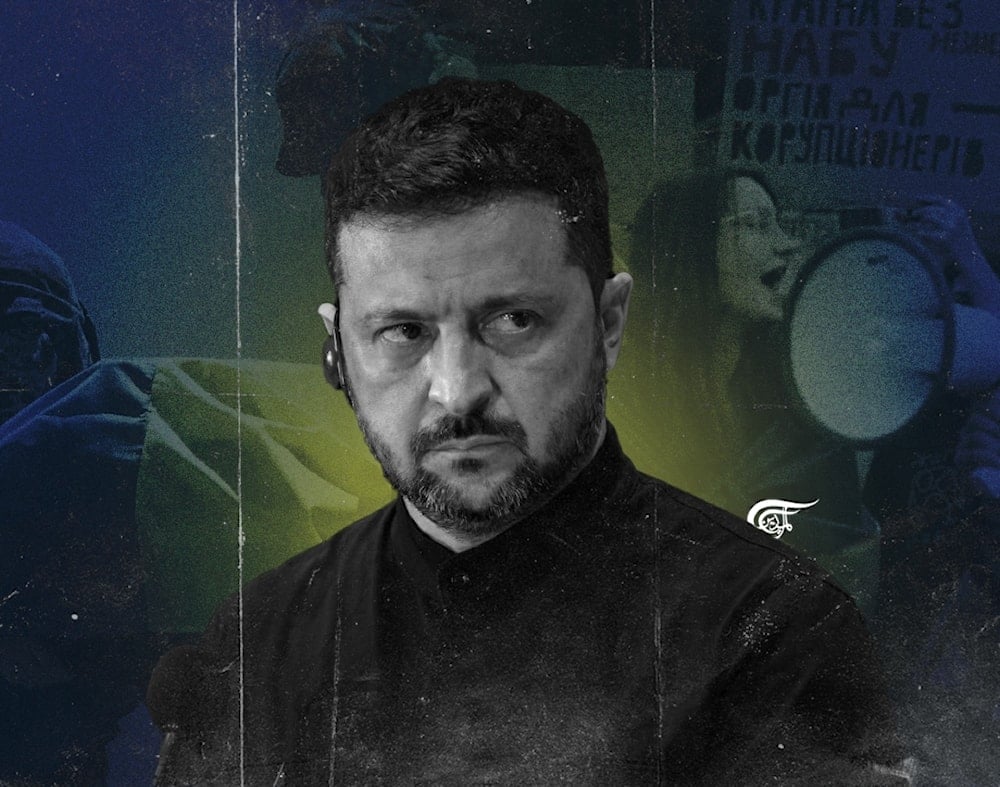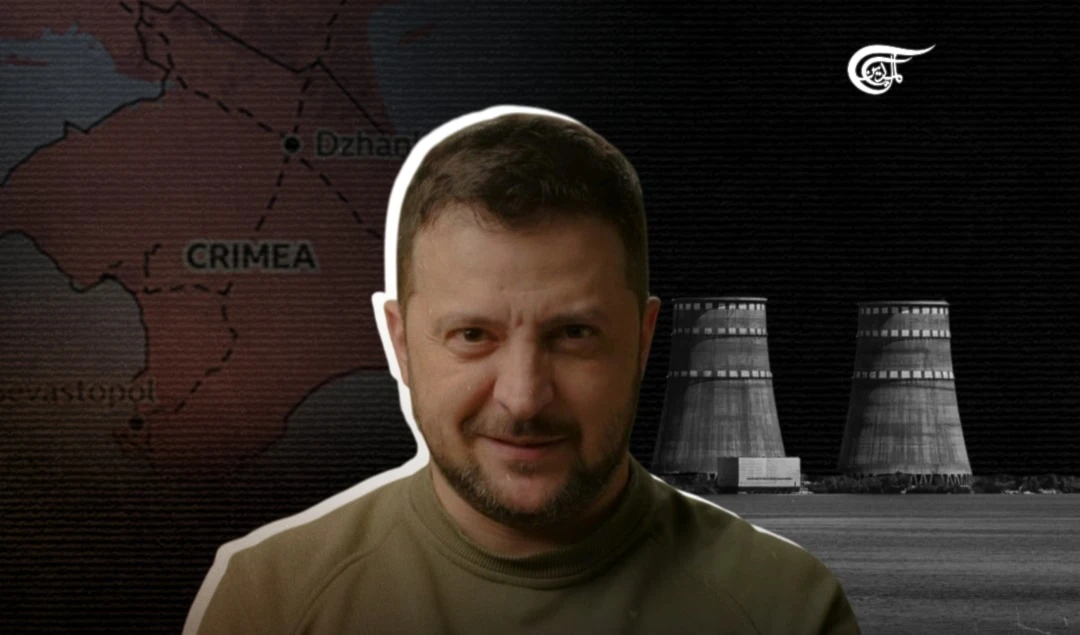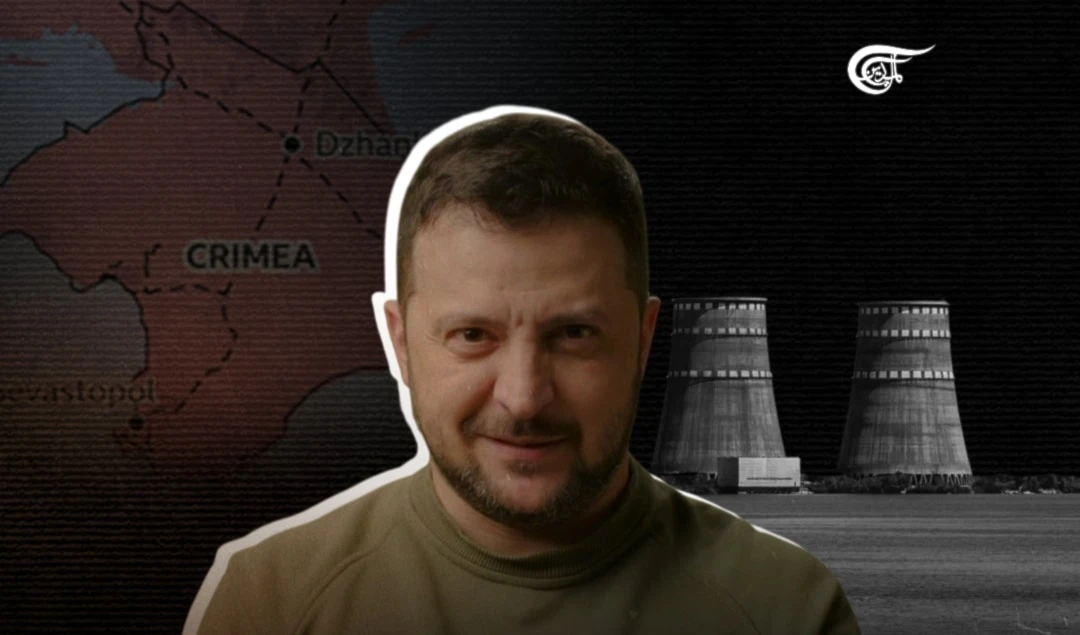Ukrainian statehood pitted against the citizens of the country
Dmitri Kovalevich argues that modern Ukrainian statehood has turned against its own people, suppressing dissent, provoking wider war, and surviving only through coercion, Western backing, and public relations.
-

Ukrainians have a cautionary term for what is taking place today in their country, ‘Don't dig a hole for someone else, or you'll fall into it yourself.’ (Al Mayadeen English; Illustrated by Zeinab el-Hajj)
On July 15, Ukraine celebrated its Day of Ukrainian Statehood established in 2023 by the administration in Kiev, then headed (as now) by Volodomyr Zelensky. On August 24, Ukraine will mark its ‘day of independence’, the date of its secession from the Soviet Union (USSR) in 1991. These two dates mark the statehood and independence of the post-Soviet Ukrainian state in 1991. However, at the time of the demise of the Soviet Union, Ukraine was already independent and sovereign, with its own seat at the United Nations General Assembly separate from the representation of the Soviet Union as a whole. This was Soviet Ukraine (the Ukrainian Soviet Socialist Republic).
What the two dates in 1991 mark is something resembling an Ireland deciding to depart the European Union (as did the UK government on January 31, 2020) and then declaring that date to be its date of statehood and independence.
The 1991 Declaration of Independence of Ukraine laid the foundation for post-Soviet Ukraine’s international recognition. It states that all nationalities within its border are guaranteed free national and cultural development. Most importantly, it says that Ukraine promises to become permanently neutral, not participating in military blocs, and renouncing the possession of nuclear weapons.
“Modern Ukraine is an absolute antithesis to what was originally stated in its declaration of independence and then its constitution. All its problems have arisen because of its acute unwillingness to do what was promised in 1991 to the people and to the world,” writes Ukrainian author Miroslava Berdnik.
If all the original, declared goals of the Ukraine founded in 1991 had been observed, at least formally, then secession by entire regions following the Maidan coup of February 2014, as well as the current war with Russia, would not have taken place. But the examples of Ukraine and many of the former republics of the USSR show that their declared goals have not been observed. In the case of Ukraine, democratic norms have served merely as smokescreens to obscure the gradual colonization of the country by Western imperialist countries.
Risk of wider war and nuclear weapons
In order to preserve its pro-Western statehood, Ukraine is provoking events that risk war between the nuclear powers of Europe and the USA, on the one hand, and the Russian Federation on the other.
Euromaidan activist and Ukrainian journalist Vitaliy Portnikov has written about this in particular. He has voiced hope that Donald Trump's administration in Washington will gift long-range weapons to Ukraine and demand that it uses them to strike Moscow and other major cities of Russia.
“Could the present war lead to a nuclear strike by Russia against Ukraine? Yes, it could. In that case, Trump could then go to war directly with Russia. That doesn't mean a World War III would start in 50 days, but the speed at which we are approaching such a scenario is definitely increasing. And yes, such a war is one of the possible scenarios for preserving Ukrainian statehood, because in the event of a global conflagration, it will be easier for geographically peripheral countries such as ours to survive.”
Ukrainian legislator Oleksandr Dubinsky, a former associate of Zelensky, currently in prison facing accusations of treason, believes that Zelensky’s regime is holding out the possibility of nuclear weapons being used against Russia by Kiev’s Western patrons. “The goal of Zelensky, his lobbyists in the EU, and a part of Trump's entourage is to achieve either the ouster of Putin or to unleash nuclear weapons,” the Ukrainian legislator writes.
Dubinsky writes that supporters of such a scenario are also considering a possible course by the Russian Federation in which it moves to implement general military conscription and considers a nuclear missile strike against Ukraine. He believes that Ukraine is now a ‘bait’ state, resembling a sheep tied to a tree in order to lure a wolf for killing or capture. In his opinion, no one in the West truly cares about the humanitarian crisis in Ukraine, nor the potential devastation of the country in an escalating war. The West wants conditions that justify continued, tough economic sanctions against the Russian Federation and the stoking of internal instability.
Simply put, the position in which the steadily retreating Ukrainian army finds itself is such that the only remaining option for Zelensky is to drag major Western countries into the conflict, dreaming of a nuclear war in which both sides destroy each other and a Zelensky-led Ukraine would survive standing.
The Ukrainian state issuing from the 2014 coup
Ukrainian statehood, as it is seen by Western countries and by the administration of the unelected Zelensky (whose electoral mandate expired in April 2024), is an enemy of the Ukrainian citizenry. The Ukrainian state, as presently constitute,d is prepared to see the country destroyed in every possible way if that be the price for this state’s own preservation. It acts as a parasite, feeding on its victim's body until it dies, following which the parasite itself dies.
The ‘modern’ (post-Soviet) state of Ukraine sent its army to suppress the rebellious people of the Donbass region (Donetsk and Lugansk republics) following the illegal coup in Kiev in February 2014. This was a direct violation of the Ukraine constitution which prohibits the use of the Ukraine army against its own citizens. Article 17 of the Ukraine Constitution reads, "The Armed Forces of Ukraine and other military formations shall not be used by anyone to restrict the rights and freedoms of citizens or with the intent to overthrow the constitutional order, subvert the bodies of power or obstruct their activity."
The post-coup government in Kiev was prevented from invading Crimea in early 2014 thanks to the decisive actions of the then-government of the Autonomous Republic of Crimea (ARC), the only such region of Ukraine with a constitutionally recognized autonomous government. The people of Donbass did not have such autonomy nor a comparable government to which they could turn for protection. The ARC government held a referendum vote on March 15, 2014, asking whether the population wished to remain under Ukrainian rule or join the Russian Federation. The government also appealed to the Russian Federation for military protection; as it happened, Russian armed forces were already present in Crimea according to the terms of the 1997 friendship treaty between post-Soviet Ukraine and the Russian Federation.
The referendum outcome was overwhelmingly in favor of affiliation with the Russian Federation. The outcome also addressed the longstanding demand by most people in Crimea to undo the arbitrary, administrative decision by the Soviet Union in 1954 to ‘attach’ Crimea to Ukraine. Crimea was a majority-Russian entity for several centuries prior, with a significant Crimean Tatar population whose language and cultural rights were never formally recognized or protected during Ukrainian rule and today are one of the three, officially recognized languages of Crimea, namely Russian, Crimea Tatar, and Ukrainian.
The state of Ukraine today continues to wage civil war against those of its population who opposed the 2014 coup and wished to maintain friendly and cooperative relations with Russia. The constitutional illegality of Kiev’s civil war in Donbass, which continues to this day, was reported and analyzed here six years ago in the Russia-based publication Baltnews.
Analysts believe Ukraine doomed to defeat
Oleksiy Arestovich, a former adviser to the Office of the President and one of Zelensky's backers until 2023, living today in exile in Europe, argues that this present-day Ukrainian state is doomed to defeat, no matter what assistance the United States and other NATO countries provide. He says there are fewer and fewer people in Ukraine willing to defend the official, far-right, ultra-nationalist ideology of this state.
Arestovich recalls that in 1918, Kiev was taken by relatively few detachments of the Red Guards as led by the renegade Russian military officer Mikhael Muravyov, while entire regiments of soldiers under the command of pro-German and pro-Western officers refused orders to fight the Red Guards. “They didn't go into battle,” writes Arestovich, “even though they could have crushed the Bolshevik Red Guards. The idea [of pro-Western Ukrainian nationalism] did not inspire them,” He regrets that such officers were inspired by a very different idea, a Ukrainian nationalism willing to subordinate the future country to the very Western imperialist powers that had created the WW1 cataclysm.
In the opinion of Arestovich, the six million Ukrainian men eligible for military service who have not served in the Ukrainian Armed Forces to date, living in clandestine conditions to avoid military recruiters, are behaving in a similar way 100 years later. He says that the right-wing Ukrainian nationalism of today - the official ideology of the country - does not inspire Ukrainian men to sign up for war, or no longer does so.
This former adviser to Zelensky is today certain that, “If the Americans were to hand over the entirety of their military arsenal to the regime in Kiev, the regime’s military would still fail sooner or later due to the shortage of infantry. A Nestor Makhno [anarchist leader during the war against imperialist intervention following the 1917 Revolution] or a Joseph Stalin would still defeat Bandera-inspired nationalism, and this for a third time in 100 years.”
A modern Ukrainian state and society dominated by far-right ideology cannot exist or survive, because 100 years of history show that the majority of the Ukrainian population does not support it. A far-right Ukraine survives only thanks to state violence and state suppression of progressive political and social alternatives.
In a supreme irony, Arestovich is himself a former activist of the neo-Nazi Brotherhood party, founded in 2004.
Arestovich believes that the governing administration in Kiev is only competent on matters of public relations and promoting its image to naïve and gullible Western audiences. It has staked its survival on media outreach and public relations warfare to pressure Western audiences and governments into supporting it by any and all means. He also argues that in contrast, Russia uses rationality and strong will to ‘roll on’ militarily and politically. “There is no stopping Russia by using sanctions against it. The Russian roller-compactor is rolling over ultra-nationalist Ukraine and will continue to do so. Long-term trends during conflict and warfare are decided by the level of organization of the state and its ability to play the long game,” Arestovich explains with more than a hint of regret.
Desertions are rising each month from the Ukrainian army, according to Ukrainian journalist Volodymyr Boyko. He reports that during the first half of 2025, according to official data, 107,672 new criminal proceedings were registered for unauthorized abandonment of military units (desertion). That is an astounding monthly average so far in 2025 of nearly 18,000 desertions. This also amounts to a crushing burden of new criminal cases for a battered Ukraine state to process.
Boyko believes the real situation to be even worse, as many cases of desertion are simply not registered. He explains that in 2025, deserters are no longer removed from the personnel lists of military units, in order to maintain illusions that units are ‘fully staffed’. What’s more, the deserters’ salaries continue to be paid and collected… by former commanders in one form or another. “As a result, there is no infantry in the Armed Forces of Ukraine today. None at all. The infantry is either on the run, in hospitals, or buried in cemeteries,” Boyko writes. According to his calculations, “realistically, there are between 30,000 and 50,000 servicemen, mostly drone operators, along the lines of contact on the Ukrainian side.”
Stanislav Bunyatov, a leader of the neo-Nazi ‘Aidar paramilitary battalion’, writes that a great many of the forcibly conscripted are choosing not to fight once transported to the front lines. “Most brigades today have demotivated personnel. If you don't kill a Russian with a drone, he will advance because Ukrainian soldiers are demotivated and, in most case,s are not willing to fight. I'm talking about our soldiers. This is understandable because there are some brigades staffed largely or exclusively by the ‘busified’. These people will not stand to the last man and there is no longer enough leadership to force them to do so. Everyone understands that soldiers are there to stand and mark the front lines, that is all,” Bunyatov writes.
(‘Busification’ («бусифікація in Ukrainian) and its derivatives are new terms introduced into the Ukrainian language in recent years. The terms describe the grim process of herding forcibly conscripted men into buses (minibuses) to be transported to training grounds and then to the military front lines. In 2024, the Myslovo Dictionary of Modern Ukrainian Language and Slang declared the word ‘busification’ to be ‘word of the year’ in Ukraine.)
In other words, soldiers are needed on the front lines under fire in order that Zelensky can claim to the political and military conferences of the Western powers, which he regularly attends, that the Ukrainian armed forces are ‘holding the front lines’.
Conscription violence… and counter-violence
In July, the Commissioner for Human Rights of the Council of Europe criticized Ukraine for human rights violations of its conscription regime, citing a report published on July 8 by Ukrainian Ombudsman Dmytro Lubynts (appointed in June 2022). The ombudsman’s report says that “human rights violations by Ukrainian officials carrying out military conscription have become systematic and widespread,” including “physical violence such as beatings, cruel detentions, denial of access to legal counsel, detentions incommunicado, conscription of persons with disabilities, and other unacceptable actions.” The EU commissioner recommends that European human rights defenders be given access to Ukraine’s conscripted soldiers to help prevent abuses.
Only the cases where EU citizens are killed or injured during military conscription in Ukraine may cause resonance in Western Europe. For example, a dual citizen of Hungary and Ukraine, József Sebestyén, was beaten to death in mid-July for resisting military recruiters in Ukraine’s Transcarpathia region, sparking protests in Budapest. But the government of Hungary is considered a ‘black sheep’ of the European Union, and so the murder of a Hungarian at the hands of Ukrainian military recruiters does not cause the same stir in the warmaking halls of power of the European Union compared to the death of a citizen of France, Germany, or Britain. (Ethnic Hungarians in Ukraine numbered 156,600 according to the Ukrainian census of 2001, the last census to take place in the country, making them the third largest national minority in the country, much of this dating back to the changing borders of Eastern Europe during the late 1930s and following World War II.)
Ukrainian political scientist Kost Bondarenko notes that resistance to military recruiters in Ukraine is definitely on the rise. “Look, there now is a reassessment of values taking place in many cities of Ukraine. The case of the unfortunate dual citizen is far from the first case. There are so many cases where people are refusing to obey a call-up to military service.” He writes of a recent attack by a group of teenagers in the city of Dnipro against military recruiters. The teenagers managed to fight off the recruiters and rescue a man they had detained.
Another phenomenon taking place sees the forcibly conscripted in Ukraine turning their guns against their own officers or Western instructors. In some cases, these are conscripted Ukrainians who have maintained their sympathies with Russia during the turbulent years since the 2014 coup, while other such cases are apolitical Ukrainians who were victims of torture or violence as they were seized and shipped off to the front lines.
In the Chernihiv region of Ukraine, media has reported of a conscripted man who killed several of his training sergeants on July 16. The conscripted man had resisted serving in the army, but he was seized and was being trained to take up arms. He turned a machine gun against his military trainers.
Once conscripted men are in the trenches, internal conflict among the troops often begins. Ukrainian nationalists are panicking over such news, claiming that “the Russians are not only in front of us but also among us.” According to reports, Russian soldiers are increasingly facing little resistance when they advance, oftentimes finding casualties and traces of fratricidal conflict in the Ukrainian trenches they overrun.
In mid-July, German citizens were able to view in a Telegram message video footage of a violent conscription confrontation in Ukraine. The message as broadcast on Telegram was headlined ‘How German viewers react to ‘busification’ in Ukraine’ and contained the written comment ‘This is definitely not Ukraine; maybe China or North Korea? It's inhumane.’
Germans were shocked by the video, and many were misled into believing that this was taking place in some foreign land such as the Democratic People’s Republic of Korea. This underlines once again how easy it is to brainwash so many EU citizens when it comes to Ukraine. Such people no doubt consider their own countries to be ‘bastions of freedom’ and Ukraine to be a ‘democracy’. But nothing resembling the events of today in Ukraine is taking place in the DPRK or in China. Such things can only happen in a country that is a vassal and willing tool of Western imperialism.
Many Ukrainian ultra-nationalists using social networks are gloating at the prospect of the citizens of Western countries - those who have cheered ‘democracy’ in Ukraine and attended rallies against ‘Russian imperialism’ while waving Ukrainian flags - will sooner or later feel the terror of forced conscription themselves. This will happen when the supply of Ukrainian soldiers, whom the West is happy to throw under the ‘steamroller’ of the Russian army, runs out, and Western leaders are obliged to turn to their own human resources to maintain their murderous, global domination. That is when the Western populations may begin to open their eyes and face the consequences of their ignorance or worse during the coup of 2014 and its continued aftermath. They may then begin to understand the inevitable but gradual and patient response by the Russian Federation to the escalating aggression by the Ukrainian state and the Western imperialist states.
Ukrainians have a cautionary term for what is taking place today in their country, namely ‘не рой другому яму – сам в нее попадешь’, meaning ‘Don't dig a hole for someone else, or you'll fall into it yourself.’
----------------------------------------------
(For background of the political evolution of Ukrainian nationalism during the 20th century, see this past essay by Dmitri Kovalevich, published in Covert Action Magazine in October 2022 and titled "Ukrainian nationalists have long history of anti-Jewish violence, which the Soviet Union opposed."

 Dmitri Kovalevich
Dmitri Kovalevich
 18 Min Read
18 Min Read












